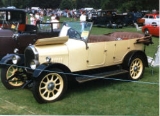
Artillery wheel
Encyclopedia
The artillery wheel was developed for use on gun carriages when it was found that the lateral forces involved in horse artillery
manoeuvres caused normally-constructed cart
wheels to collapse. Rather than having its spoke
s mortise
d into a wooden nave (hub), it has them fitted together (mitred
) then bolted into a metal nave. Its tyre is shrunk onto the rim in the usual way but it is also bolted on for security. A normal wagon
wheel
is dished so that in its lowest part, the spokes are perpendicular to the ground thus supporting the weight (with the axle not truly horizontal but angled downward toward the outside about 5 degrees). This is not done with artillery wheels.
 When higher speeds and consequently higher lateral forces were attained with the introduction of motor vehicles, the artillery wheel was used in those too. By the 1920s, motor cars used wheels which looked at a glance like artillery wheels but which were of forged steel or welded from steel pressed sections. These too were usually called artillery wheels. By the 1930s they were obsolete having been replaced by wheels pressed from heavy-gauge steel
When higher speeds and consequently higher lateral forces were attained with the introduction of motor vehicles, the artillery wheel was used in those too. By the 1920s, motor cars used wheels which looked at a glance like artillery wheels but which were of forged steel or welded from steel pressed sections. These too were usually called artillery wheels. By the 1930s they were obsolete having been replaced by wheels pressed from heavy-gauge steel
sheet or in sports cars and lightweight cars, by wire spokes.
Horse artillery
Horse artillery was a type of light, fast-moving and fast-firing artillery which provided highly mobile fire support to European and American armies from the 17th to the early 20th century...
manoeuvres caused normally-constructed cart
Cart
A cart is a vehicle designed for transport, using two wheels and normally pulled by one or a pair of draught animals. A handcart is pulled or pushed by one or more people...
wheels to collapse. Rather than having its spoke
Spoke
A spoke is one of some number of rods radiating from the center of a wheel , connecting the hub with the round traction surface....
s mortise
Mortise
Mortise or mortice may refer to:* Mortise and tenon, a woodworking joint* Ankle mortise, part of the distal tibia joining the talus bone to form an ankle joint* Mortise chisel, a type of chisel* Mortice lock - a deadlocking lock....
d into a wooden nave (hub), it has them fitted together (mitred
Miter joint
A miter joint , sometimes shortened to miter, is a joint made by bevelling each of two parts to be joined, usually at a 45° angle, to form a corner, usually a 90° angle...
) then bolted into a metal nave. Its tyre is shrunk onto the rim in the usual way but it is also bolted on for security. A normal wagon
Wagon
A wagon is a heavy four-wheeled vehicle pulled by draught animals; it was formerly often called a wain, and if low and sideless may be called a dray, trolley or float....
wheel
Wheel
A wheel is a device that allows heavy objects to be moved easily through rotating on an axle through its center, facilitating movement or transportation while supporting a load, or performing labor in machines. Common examples found in transport applications. A wheel, together with an axle,...
is dished so that in its lowest part, the spokes are perpendicular to the ground thus supporting the weight (with the axle not truly horizontal but angled downward toward the outside about 5 degrees). This is not done with artillery wheels.

Steel
Steel is an alloy that consists mostly of iron and has a carbon content between 0.2% and 2.1% by weight, depending on the grade. Carbon is the most common alloying material for iron, but various other alloying elements are used, such as manganese, chromium, vanadium, and tungsten...
sheet or in sports cars and lightweight cars, by wire spokes.

